|
Week 2: August 8-14, 2012 |
Welcome
to the McGill Bird Observatory weekly report.
Click here for a complete listing of our archives.
Comments or
questions are welcome at "mbo AT migrationresearch.org".
|
PICTURE
OF THE WEEK: |
|
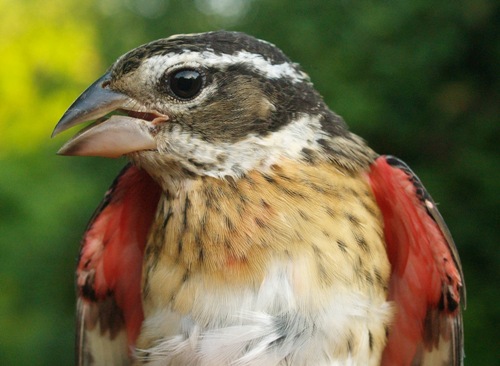
Rose-breasted Grosbeaks are one of MBO's August specialties; here we have a
hatch-year male giving away his identity through his underwing linings
(Photo by Simon Duval)
-
|
|
|
THIS WEEK |
THIS FALL |
2012 TOTAL |
SITE TOTAL |
|
# birds (and species) banded |
243 (41) |
524 (45) |
1789 (78) |
37540 (108) |
|
# birds (and species) repeat |
74 (21) |
124 (23) |
462 (42) |
6875 (69) |
|
# birds (and species) return |
7 (4) |
20 (12) |
159 (23) |
1120 (38) |
|
# species observed |
85 |
92 |
152 |
207 |
|
# net hours |
552.0 |
1112.0 |
4371.8 |
63470.9 |
|
# birds banded / 100 net hours |
44.0 |
47.1 |
40.9 |
59.1 |
|
|
Note: table does not include nocturnal banding (owls) |
|
Banders-in-charge: Simon Duval, Gay Gruner
Assistants: Richard Beauchamp, Suzanne Bérard, Nicolas Bernier, Emily Boulanger, Rui de Jesus, Jean Demers, Leah den Besten, Tammy Elliott, Liette Fortier, Barbara Frei, Louise Gagné, Nathalie Gendron, Tiffany Gilchrist, Monique Groulx, Alison Hackney, Myriam Haineault, Lisa Keelty, Shelly Kirk, Patrick Laniel, Marie-Pier Laplante, Francine Marcoux, Yves Payette, Lisa Rosenberger, Clémence Soulard, Carine Touma
Notes: Typically numbers drop off a bit in week 2, and this year was no exception. However, the 243 birds banded this week was again a new record for the time period, and as such, in combination with last week's record, the total for the season is more than 80 individuals ahead of any previous year - certainly a promising start to fall 2012! In part, this success is thanks to a phenomenal run of good weather so far, with only 8 net hours missed to date out of a potential total of 1120. The lack of strong weather fronts also seems to be keeping more birds hanging around, with a record 74 repeats this week. Diversity has also been impressive, with the 85 species observed this week and cumulative total of 92 for the season also both record high tallies.
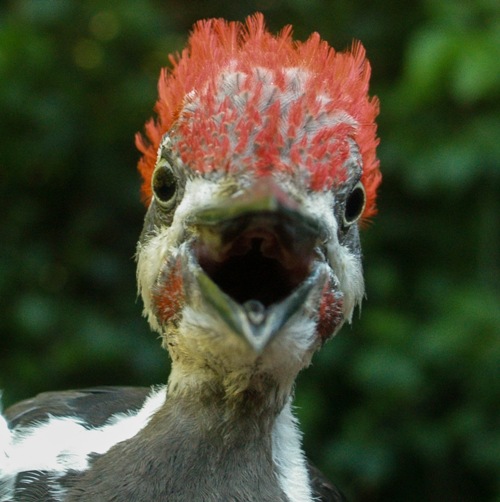
Always a rare treat, this Pileated Woodpecker was just the third of its kind banded during the Fall Migration Monitoring Program at MBO.
(Photo by
Simon Duval) |
Early in the season, it is easy to rack up a long list of additions to our seasonal checklist. This week's new observations were Canada Goose, Black-crowned Night Heron, Merlin, American Kestrel, Herring Gull, Black-billed Cuckoo, Rock Pigeon, Yellow-bellied Sapsucker, Eastern Wood-Pewee, Eastern Phoebe, Willow Flycatcher, Yellow-bellied Flycatcher, Common Raven, Red-breasted Nuthatch, Mourning Warbler, Cape May Warbler, Black-throated Blue Warbler, House Finch, and Pine Siskin. Three of these (Black-crowned Night Heron, Black-billed Cuckoo, and Yellow-bellied Flycatcher) had not been observed previously in 2012. Our seasonal and annual banding checklists also grew nicely this week, with our first Pileated Woodpecker, Willow Flycatcher, Yellow-bellied Flycatcher, Mourning Warbler, Scarlet Tanager, and House Finch of 2012, plus our first Sharp-shinned Hawk, Northern Flicker, Hairy Woodpecker, Great-crested Flycatcher, and Black-throated Blue Warbler of this fall. Also of note, we had our first Black-and-white Warbler return and our first Veery, Swainson's Thrush, Nashville Warbler, and Canada Warbler repeats of the year.
|
This week’s top 10
[last week's rank in brackets]
|
# individuals banded |
mean # individuals observed daily |
|
1. American Redstart (39) [4] |
1. Common Grackle (69)
[10] |
|
2. Song Sparrow (37) [1] |
2. American Goldfinch (24) [2] |
|
3. Traill's Flycatcher (14)
[-] |
3. Cedar Waxwing (22)
[3] |
|
4. Baltimore Oriole (11)
[10] |
4. Song Sparrow (18)
[6] |
|
5. Cedar Waxwing (10) [5] |
5. Black-capped Chickadee (17)
[5] |
|
5. Common Yellowthroat (10) [3] |
6. American Crow (16) [1] |
|
7. Red-eyed Vireo (9)
[5] |
7. American Robin (15)
[4] |
|
7. Swainson's Thrush (9) [-] |
8. Canada Goose (12) [-] |
|
7. Yellow Warbler (9)
[2] |
9. European Starling (10) [-] |
|
10. Gray Catbird (8) [8]
|
10. Baltimore Oriole (7)
[-] |
|
Eight of last week's top ten species banded remained on the list this week, with only White-throated Sparrow and Black-capped Chickadee being bumped by Traill's Flycatcher and Swainson's Thrush. American Redstart fall counts at MBO have increased for six consecutive years, with mid-August to early September typically the peak period. This marks the third time (after 2008 and 2010) that American Redstart has dominated week 2, and the 39 individuals banded this week is a record count for this early in the season. Close behind in second place was Song Sparrow, already at 92 for the season. Week 2 is often the peak of Traill's Flycatcher migration, but even so, this week's count was impressively high. Except for one small individual that measured out as a Willow Flycatcher, chances are the rest were all Alder Flycatchers. Rising to fourth place this week was Baltimore Oriole; in combination with last week's count, the season total is already at 19 individuals, more than we have banded in any of the past three fall seasons. Cedar Waxwing, Common Yellowthroat, and Red-eyed Vireo continued strong after a good start last week, while Yellow Warbler dropped all the way to 9th place, and Gray Catbird hung on at the bottom of the top ten. The biggest surprise this week was Swainson's Thrush in a tie for 7th place. Although in recent years we have seen an increasing number of Swainson's Thrushes show up at MBO as moult migrants, we had never before had more than four in one week, a total that was more than doubled this week
Among species observed, the top seven this week were also on last week's list, while the newcomers at the bottom of the list (Canada Goose, European Starling, and Baltimore Oriole) displaced Yellow Warbler, Common Yellowthroat, and Red-winged Blackbird. Common Grackle jumped from tenth to first place this week; grackles also ruled the top spot in week 2 back in 2008 and 2009, but vary widely in abudance from year to year depending on timing and location of flock formation. American Goldfinch and Cedar Waxwing rounded out the top three like last week, and the middle of the list was a tightly bunched group of species mostly shuffling around slightly from last week, except for American Crow dropping out of top spot all the way to sixth place.
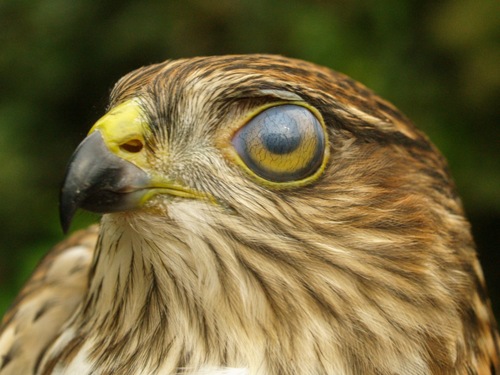
Here's the first Sharp-shinned Hawk banded this fall - note that the protective nictitating membrane is completely covering the eye in this shot.
(Photo by
Simon Duval) |
Since 2008 (and for some species since 2006), we have documented a pattern in which a number of species peak in abundance in the "even" years, most notably several warblers, and with Yellow-rumped Warbler exhibiting the greatest fluctuations. It will be late September before we get any real indication about Yellow-rumped Warblers, but some of the other species will be peaking sooner, and we look forward to seeing whether in fact 2012 will develop into another exceptionally productive season.
|
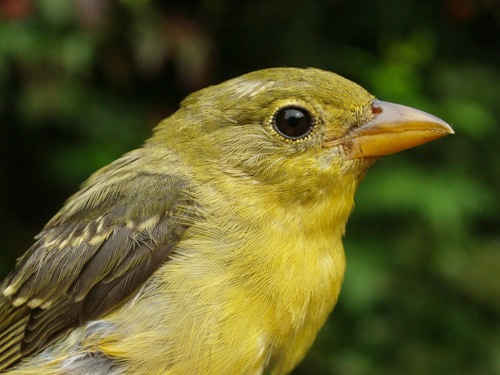
For the past two years, we've banded just a single Scarlet Tanager each fall - will this hatch-year female be the only one of 2012?
(Photo by
Simon Duval)
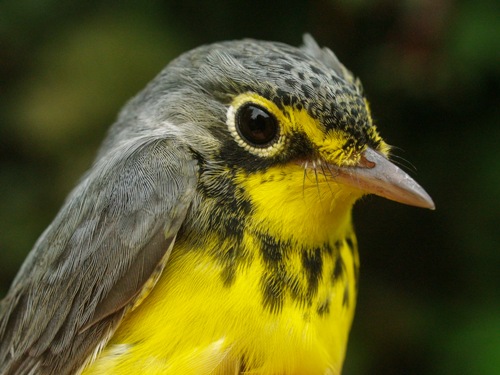
Another August specialty, and one of our favourites - Canada Warbler.
(Photos by
Simon Duval)
|





